Our contemporary way of reading a compass is called the “three-figure” method, referring to the three numerals called out to the helmsperson by the navigator, as in “steer three-two-zero.” Early compass cards, however, were divided not into 360 degrees but into 32 points, each one equivalent to 11 degrees, 15 minutes, about the best the early ships could steer. Compass bearings were “East-Southeast” or “West by North.” Now you might think “West by North” would translate to 315 degrees, halfway between west at 270 and north at 360. But that’s “Northwest.” Instead, “West by North” is one point north of west or 281.25 degrees. The sequence from West to North in points is: W, W by N, WNW, NW by W, NW, NW by N, NNW, N by W, N. Film buffs may notice that Alfred Hitchcock’s “North by Northwest” is not on this list, because, as the master of mystery knew, there is no such direction.

Later, things got uglier when, as navigational skills improved, points were divided into halves and quarters, yielding indecipherable directions like “East by North ¾ North.” Reciting these divisions was called “boxing the compass,” and I’m relieved it was in most instances replaced by our modern (actually ancient Babylonian) 360 degree system so I don’t have to know it. On my good days, I can count to 360.
Relative bearings in points were, for example, “two points on the starboard bow,” which translates to 022.5 degrees relative to the ship’s heading. Four points adds up to 045 degrees, voiced as “broad on the starboard bow;” 090 is “starboard abeam;” and 135 would be “broad on the starboard quarter.” A vestige of this practice can be found in the transition between the arc of sidelights and stern light that occurs at 22.5 degrees abaft the beam. Why not an even number? Because 22.5 degrees is two points abaft the beam.
So now you know just how to talk on those “sail like a pirate” days: “Aaaargh, matey, she’s hull down, one point forward of the port beam. Steer Southeast by East, sir.” Folks, just a little of this sort of thing will make a lasting impression on your shipmates. Trust me.

Dear Friends:
Can you identify what is meant by the ‘”first quarter” of a ship. This must be a very old sailing ship term. I came across this expression in a newspaper article from 1866, in which a ship’s officer described how, during a gale, several seas struck his steamship on the “first quarter.” Modern terminology uses port and starboard quarter, beam and forward (or bow) to describe what part of the ships hull is referred to.
I would appreciate your asking about if anyone knows. I am just an armchair sailor.
Regards
Joseph R Ornig
Lake Bluff, Illinois
That is a great question. I’ve not heard that usage before and so am sorry to say I can’t help much. Although a ship has four quarters, as the word suggests, “quarter” is generally used to indicate 45 degrees abaft the beam on either side. 45 degrees forward of the beam is generally “broad on the (starboard) bow.” Online I found no help so I’ll consult my various nautical dictionaries, two of which are quite ancient, and get back to you!
OK, Joseph. I have done a search on “first quarter.” Online I found the only references were for the first quarter of the moon, and the first quarter of the year, as in “we had a good first quarter.” In my collection of nautical dictionaries, beginning with Falconer in 1789 and Smyth in 1867, both from the great days of sail, and even including “A Sea Of Words” which is the lexicographical companion to the Patrick O’Brian novels, I find the consistent reference to quarter as meaning between astern and abeam. A quartering sea is one hitting the ship on the port or starboard quarter. There is no mention of first quarter, with this one exception, which appears not to apply in this context: yards are divided into the first, second, third quarter, and then yardarm. I find it very possible that the ship’s officer was misquoted by the newspaper correspondent. The San Francisco Chronicle for many years had a writer who knew about the sea, but this is not normal, although it was more normal in the year of your publication. Outside of actual sailing publications, I often find misused concepts or terms in newspaper articles. Don’t get me started. If you find out more, let me know for sure!